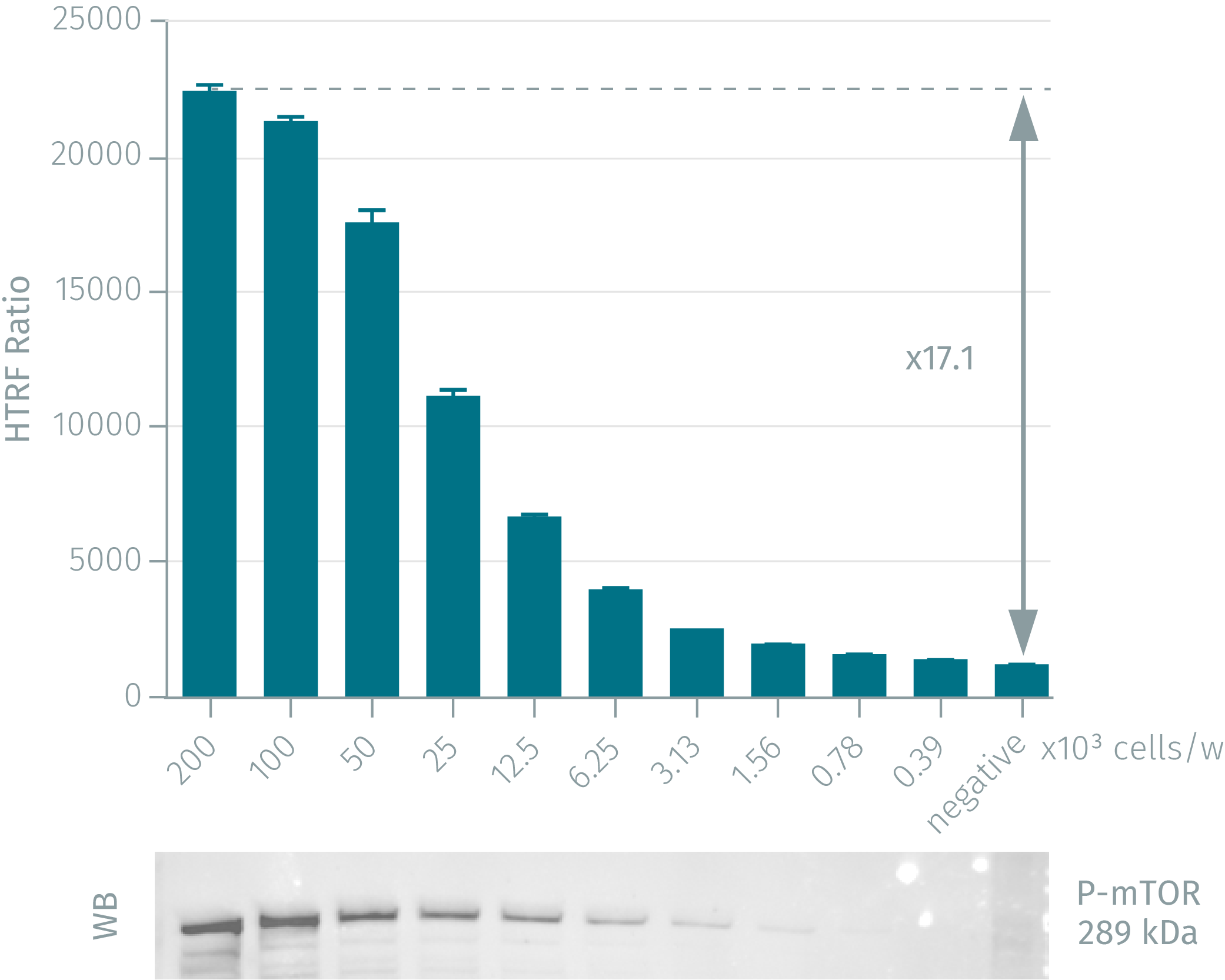

HTRF Human & Mouse Phospho-mTOR (Ser2448) Detection Kit, 500 Assay Points


HTRF Human & Mouse Phospho-mTOR (Ser2448) Detection Kit, 500 Assay Points






The phospho-mTOR (Ser2448) kit enables the cell-based quantitative detection of phosphorylated mTOR.
For research use only. Not for use in diagnostic procedures. All products to be used in accordance with applicable laws and regulations including without limitation, consumption and disposal requirements under European REACH regulations (EC 1907/2006).
| Feature | Specification |
|---|---|
| Application | Cell Signaling |
| Sample Volume | 16 µL |
The phospho-mTOR (Ser2448) kit enables the cell-based quantitative detection of phosphorylated mTOR.
For research use only. Not for use in diagnostic procedures. All products to be used in accordance with applicable laws and regulations including without limitation, consumption and disposal requirements under European REACH regulations (EC 1907/2006).



HTRF Human & Mouse Phospho-mTOR (Ser2448) Detection Kit, 500 Assay Points



HTRF Human & Mouse Phospho-mTOR (Ser2448) Detection Kit, 500 Assay Points



Product information
Overview
The Phospho-mTOR (Ser2448) cellular assay kit is ideal for measuring phosphorylated mTOR directly in cells. Using a streamlined protocol, amenable to low-volume formats, this kit can be used from basic research to High Throughput drug screening.
Specifications
| Application |
Cell Signaling
|
|---|---|
| Brand |
HTRF
|
| Detection Modality |
HTRF
|
| Lysis Buffer Compatibility |
Lysis Buffer 1
Lysis Buffer 3
Lysis Buffer 4
Lysis Buffer 5
|
| Molecular Modification |
Phosphorylation
|
| Product Group |
Kit
|
| Sample Volume |
16 µL
|
| Shipping Conditions |
Shipped in Dry Ice
|
| Target Class |
Phosphoproteins
|
| Target Species |
Human
Mouse
|
| Technology |
TR-FRET
|
| Therapeutic Area |
Cardiovascular
Metabolism/Diabetes
NASH/Fibrosis
Neuroscience
Oncology & Inflammation
|
| Unit Size |
500 Assay Points
|
Video gallery

HTRF Human & Mouse Phospho-mTOR (Ser2448) Detection Kit, 500 Assay Points

HTRF Human & Mouse Phospho-mTOR (Ser2448) Detection Kit, 500 Assay Points

How it works
Phospho-mTor (Ser2448) assay principle
The Phospho-mTor (Ser2448) assay measures mTor when phosphorylated at Ser2448. Contrary to Western Blot, the assay is entirely plate-based and does not require gels, electrophoresis or transfer. The Phospho-mTor (Ser2448) assay uses 2 labeled antibodies: one with a donor fluorophore, the other one with an acceptor. The first antibody is selected for its specific binding to the phosphorylated motif on the protein, the second for its ability to recognize the protein independent of its phosphorylation state. Protein phosphorylation enables an immune-complex formation involving both labeled antibodies and which brings the donor fluorophore into close proximity to the acceptor, thereby generating a FRET signal. Its intensity is directly proportional to the concentration of phosphorylated protein present in the sample, and provides a means of assessing the proteins phosphorylation state under a no-wash assay format.

Phospho-mTor (Ser2448) 2-plate assay protocol
The 2 plate protocol involves culturing cells in a 96-well plate before lysis then transferring lysates to a 384-well low volume detection plate before adding phospho-mTor (Ser2448) HTRF detection reagents. This protocol enables the cells' viability and confluence to be monitored.

Phospho-mTor (Ser2448) 1-plate assay protocol
Detection of Phosphorylated mTor (Ser2448) with HTRF reagents can be performed in a single plate used for culturing, stimulation and lysis. No washing steps are required. This HTS designed protocol enables miniaturization while maintaining robust HTRF quality.

Assay validation
HTRF assay compared to WB using phospho-mTOR cellular assay
Hek293 cells were grown in a T175 flask 37°C, 5% Co2, 2 days.After elimination of cell culture medium, 3 mL of supplemented lysis buffer were added and incubated for 30 min.Soluble supernatants were collected after 10 min centrifuging. Equal amounts of lysates were used for a side by side comparison of WB and HTRF. HTRF assay shows the same level of sensitivity as Western Blot: 1560 cells for the two technologies.

Insulin dose-response on NIH 3T3 cells
Murine NIH 3T3 cells (100,000 cells/well) were stimulated for 30 minutess at 37°C with various concentrations of forskolin. After a 30 minutes lysis incubation time, phosphorylated mTOR was measured using the two-plate assay protocol.

Inhibition effect of Rapamycin on basal level of Jurkat cells
Jurkat cells (100,000 cells/well) were incubated for 30 min at 37°C with various concentrations of inhibitor. After a 30 minutes lysis incubation time, inhibition of the basal level of phosphorylated mTOR was measured using the one-plate assay protocol.

Simplified pathway
Simplified Pathway for Phospho-mTor (Ser2448) assay kit
The mammalian target of rapamycin (mTOR) is a Ser/Thr protein kinase that functions as an ATP and amino acid sensor and plays a key role in cell growth and homeostasis. As mTOR may be abnormally regulated in tumors, it is currrently under investigation as a potential target for anti-cancer therapy. mTOR is itself phosphorylated at Ser2448 via the PI3 kinase/Akt signaling pathway, and autophosphorylated at Ser2481.

Resources
Are you looking for resources, click on the resource type to explore further.
Atherosclerosis pathogenesis, cellular actors, and pathways
Atherosclerosis is a common condition in which arteries harden and...
Neurodegenerative diseases, such as Alzheimer’s, Parkinson’s, and Huntington’s, are complex disorders that affect millions...


How can we help you?
We are here to answer your questions.






























